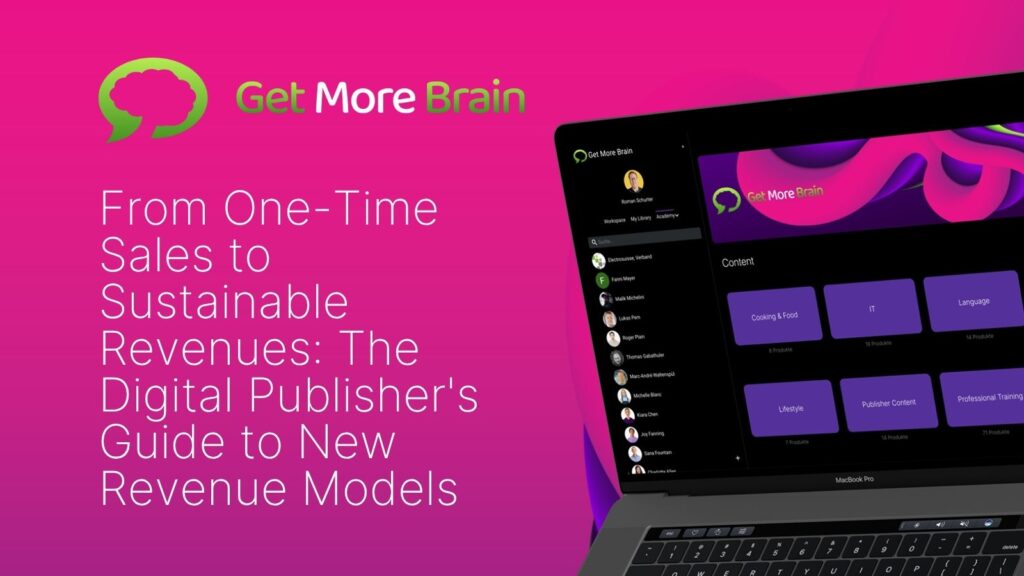From One-Time Sales to Sustainable Revenues: The Digital Publisher’s Guide to New Revenue Models
- Roman Schurter

Table of Contents
In the digital content ecosystem, sustainable revenue generation has become the holy grail for publishers, associations, and standards development organizations.
The transition from traditional one-time sales to recurring revenue models isn’t just a trend – it’s an essential transformation for thriving in today’s market.
At Get More Brain, we’ve observed how the most successful content providers are radically rethinking their revenue structures.
Let’s explore the most promising revenue models reshaping the publishing landscape.
Why Single Sales Are Fading (And That’s Good News)
The traditional model of selling individual content items – whether books, standards, or training modules – is increasingly being challenged. One-time transactions create unpredictable revenue streams and leave significant value on the table.
Instead, forward-thinking publishers are embracing subscription-based approaches that create predictable, recurring income while actually delivering more value to customers. This shift from ownership to access fundamentally changes the publisher-user relationship for the better.
Five Revenue Models Reshaping Digital Publishing
1. Strategic Subscription Bundling
The subscription economy has firmly taken root in publishing, but the most successful implementations go beyond basic “all-you-can-access” models. Strategic bundling – creating thoughtfully curated content packages for specific user segments – delivers higher perceived value and justifies premium pricing.
Publishers and associations are finding success with:
- Tiered subscription offerings (Basic/Professional/Enterprise) targeting different user segments
- Role or industry-specific bundles (e.g., “All Standards for Electricians”)
- Combined media packages that merge digital and print offerings
The key insight: When bundling, focus on creating genuine user value rather than simply grouping random content together. The strongest bundles solve specific problems for clearly defined audiences.
2. Institutional and B2B Licensing
Perhaps the most transformative shift for many publishers has been embracing institutional licensing models. Rather than pursuing individual sales, publishers are creating bulk access agreements with organizations, dramatically increasing both revenue and market penetration.
This approach is particularly effective for:
- Professional associations providing member access to standards and learning resources
- Corporate publishers deploying content across entire departments or organizations
- Educational publishers working with universities and libraries
The business case is compelling: While individual sales might reach only a fraction of potential users, institutional licensing can place your content in front of every relevant professional in an organization while generating higher, more predictable revenue.
3. Subscribe-to-Open Models
A fascinating hybrid approach merging open access principles with sustainable economics, the Subscribe-to-Open (S2O) model invites institutions to subscribe to content that will be made openly available if sufficient subscription revenue is received.
S2O allows publishers to convert journals from subscriptions to Open Access, one year at a time. Using S2O, a publisher offers a journal’s current subscribers continued access. If all current subscribers participate in the S2O offer (simply by not opting out) the publisher opens the content covered by that year’s subscription. If participation is not sufficient—for example, if some subscribers delay renewing in the expectation that they can gain access without participating—then that year’s content remains gated.
The offer is repeated every year, with the opening of each year’s content contingent on sufficient participation. In some cases, access to backfile content may be used to enhance the offer.
This model has gained significant traction in academic and technical publishing, offering a compelling alternative to traditional paywalls while ensuring sustainable funding. Organizations benefit from wider content distribution and impact while maintaining revenue streams.
For standards bodies and professional associations, S2O represents an innovative approach to balancing accessibility with financial sustainability.
4. AI Content Licensing
An entirely new revenue stream has emerged as AI companies seek high-quality content to train and refine their models. Publishers with valuable archives of factual, well-structured content are now licensing these assets to AI developers.
For example, Reuters has established significant AI content licensing partnerships, creating new revenue while ensuring its journalistic standards are maintained. Similarly, technical publishers and standards organizations are finding that their structured, authoritative content holds significant value in the AI training marketplace.
This model works particularly well when content is already structured in machine-readable formats – exactly the kind of digital transformation many publishers are already undertaking for other reasons.
5. Private Label and White-Label Solutions
Some publishers are finding success by moving beyond content licensing to offering complete white-labeled platforms. In this model, the publisher powers a partner’s branded content portal, handling the technology while the partner manages branding and customer relationships.
This approach creates deeper partnerships with organizational customers while leveraging existing content assets and technical infrastructure. For publishers with strong content management systems, this can represent a significant new revenue stream with relatively low marginal costs.
Implementation: Starting Your Revenue Transformation
For publishers considering a revenue model transformation, we recommend a phased approach:
- Analyze your audience: Identify which segments would benefit most from subscription or licensing models
- Start with pilot programs: Test new models with selected customer groups before full rollout
- Consider hybrid approaches: Maintain some transactional options while building subscription revenue
- Focus on value communication: Clearly articulate the benefits of new models to customers
- Invest in necessary technology: Ensure your platforms can support flexible access and licensing models
The Future Is Recurring Revenue
The most successful publishers are those who recognize that sustainable business models require predictable, recurring revenue streams. By shifting from one-time transactions to relationship-based models like subscriptions, licensing, and partnerships, publishers create both business stability and enhanced user value.
These models aren’t merely financial strategies – they represent a fundamental reimagining of the publisher’s role from content seller to ongoing service provider. In this evolution lies the future of sustainable publishing.
What recurring revenue model would provide the most value to your audience? The answer to that question may well determine your organization’s long-term success in the digital content marketplace.


